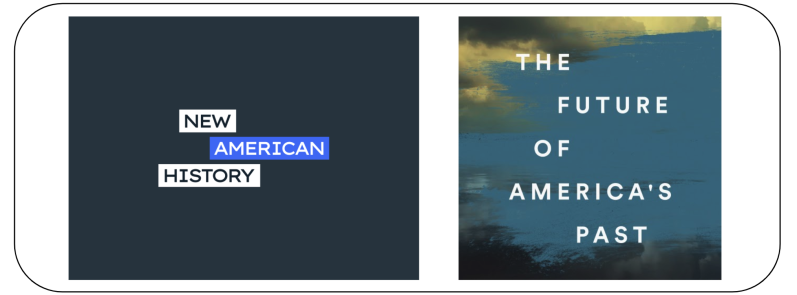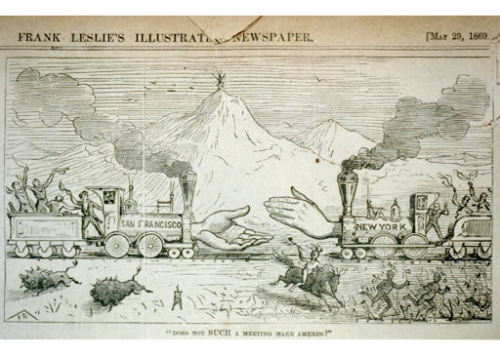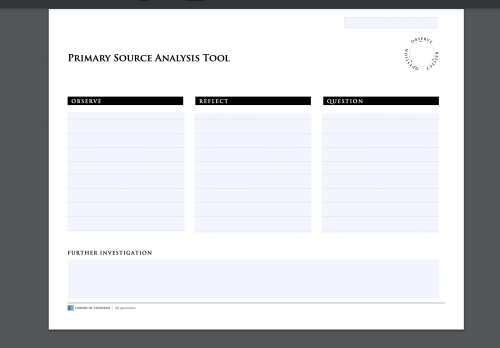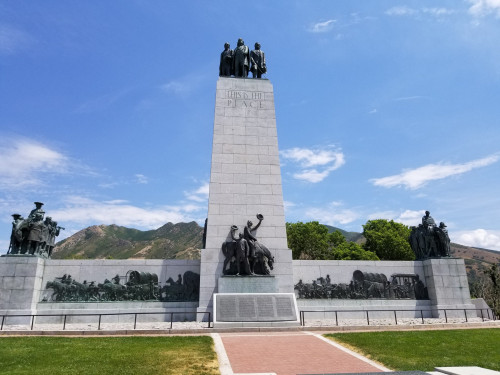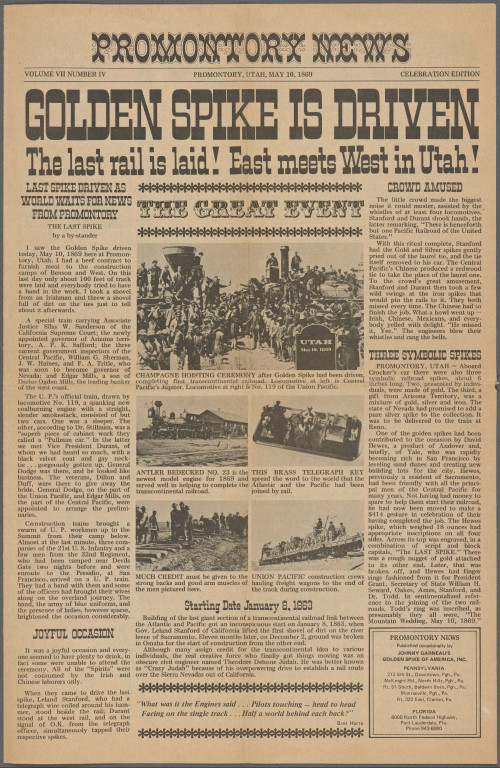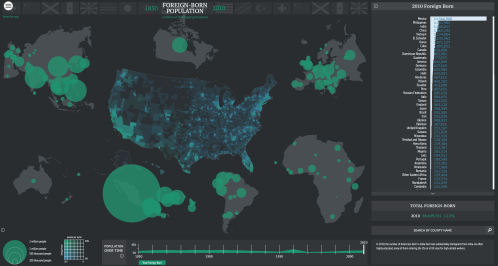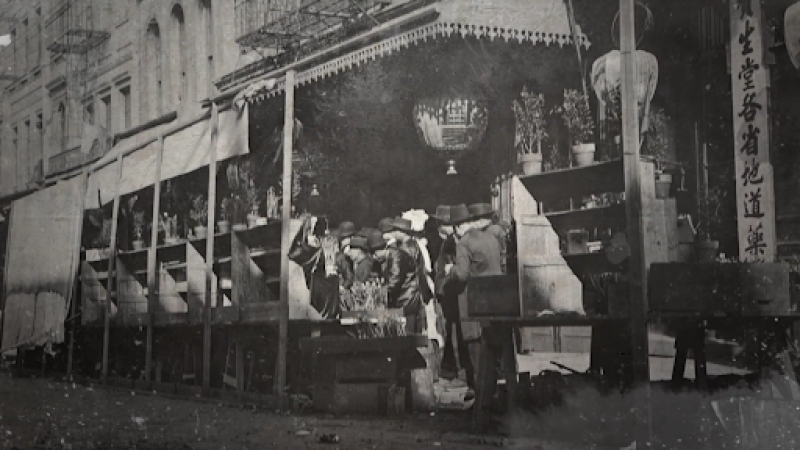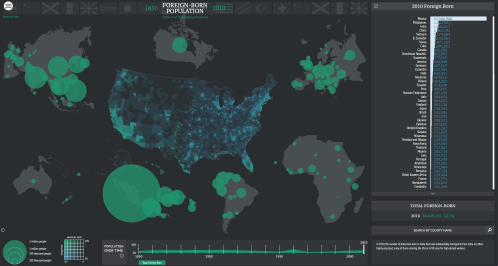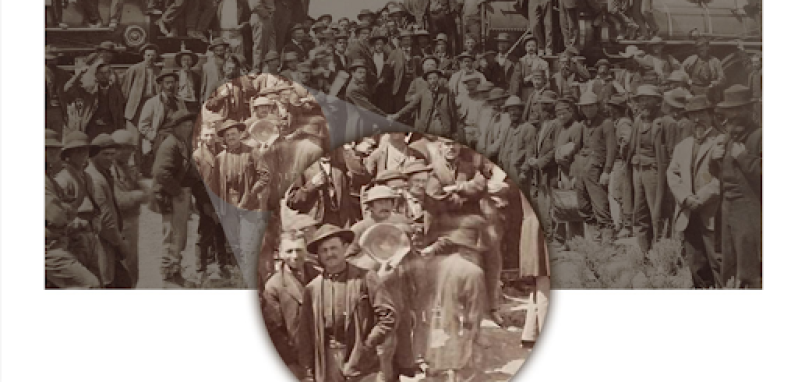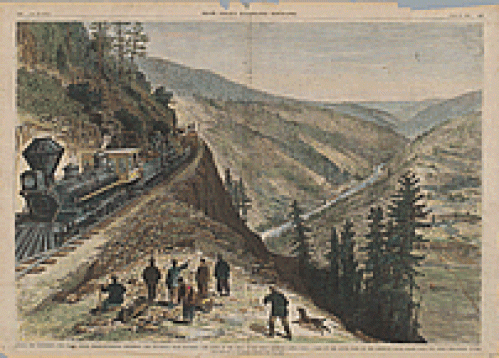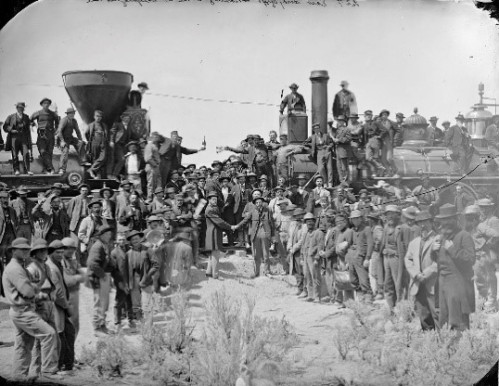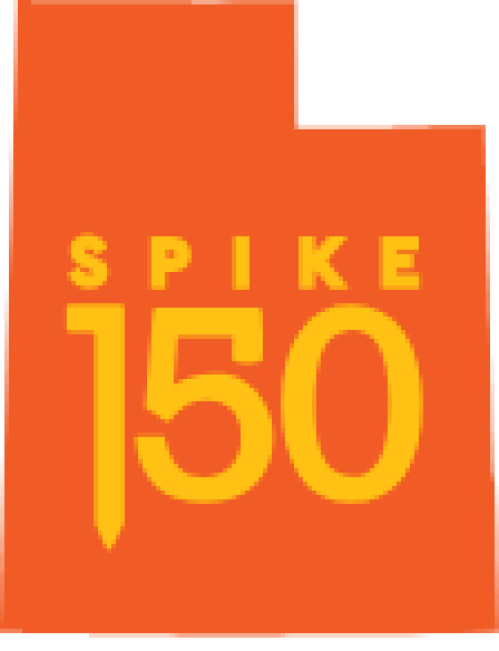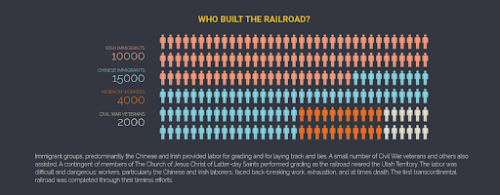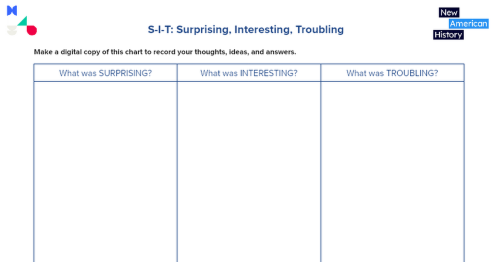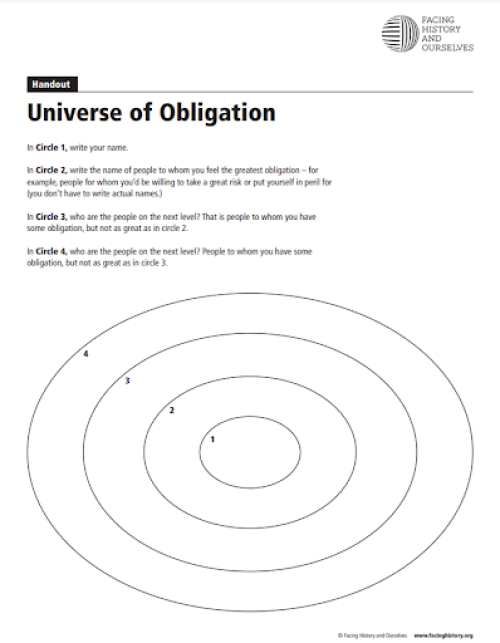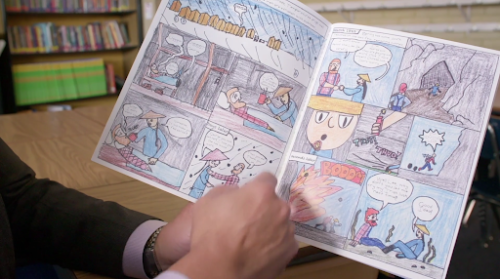This work by New American History is licensed under a Attribution-NonCommercial-ShareAlike 4.0 (CC BY-NC-SA 4.0) International License. Permissions beyond the scope of this license may be available at newamericanhistory.org.
Transcontinental
View Student Version
Standards
C3 Framework:D2.Geo.3.3-5. Use maps of different scales to describe the locations of cultural and environmental characteristics.D2.Geo.5.3-5. Explain how the cultural and environmental characteristics of places change over time.D2.His.3.3-5. Generate questions about individuals and groups who have shaped significant historical changes and continuities.D2.His.3.6-8. Use questions generated about individuals and groups to analyze why they, and the developments they shaped, are seen as historically significant.
National Council for Social Studies:Theme: Time, Continuity, ChangeTheme: Culture
National Geography Standards: Standard 4. The physical and human characteristics of places.Standard 6. How culture and experience influence people’s perceptions of places and regions.
Teacher Tip: Think about what students should be able to KNOW, UNDERSTAND, and DO at the conclusion of this learning experience. A brief exit pass or other formative assessment may be used to assess student understandings. Setting specific learning targets for the appropriate grade level and content area will increase student success.
Suggested Grade Levels: Middle School/High School
Suggested Timeframe: 5 class sessions, 45 minute class periods or 3 class sessions, 90-minute blocks
Suggested Materials: Internet access via laptop, tablet, mobile device, or projector and screen for viewing video segments as a whole group if providing face-to-face instruction. Access to video conferencing if providing instruction via remote learning or hybrid teaching models.
Key Vocabulary
Combustive - fire-powered, flammable
Commemorate/memorialize - to honor the memory of a person or event
Commissioned - to pay for/request a person to complete a task or create a work of art
Convey - to express, transfer, or exchange information
Counter Argument - using evidence to challenge, express, and support an opposing point of view
Diverting - to turn away from or distract
Empathy - the ability to imagine oneself in the situation of another, experiencing the emotions, ideas, or opinions of that person
Enterprise - a difficult, bold, or risky plan or project
Garrison - a military fort, a group of soldiers within a fort
Genocide - to attempt to permanently destroy all members of a race, nationality, or ethnic group
Humanity - people, human beings
Hunter-gatherer - a group of people who traveled to hunt, fish, and gather food in the wild
Incentive - to motivate, reward, or bribe someone to complete a task
Infographic - a visual image such as a chart or diagram used to represent information or data
Infrastructure - basic facilities, equipment, and technology to keep a system or organization functioning
Locomotives - a self-powering engine used to push or pull a train along a railroad track
Massacre - to kill a large number of people or animals in a cruel way
Narrative - a story, description, or account of an event, told from a historical perspective
Naysayer - a person who objects, criticizes or opposes another person or idea
Overland - passing or traveling across the land
Predominant - having great importance, power, or authority
Reenactor - a person who acts out a role from a past event or time, a historical interpreter
Refute - to prove to be wrong, or contradict
Representation - diversity among people in positions of power and authority (including the workplace, government, education, justice system, and healthcare) and the media we use to tell and share stories, which should represent everyone, not just a few.
Reservation - an area of land set aside by the U.S. government for Native Americans removed from their land to make room for white settlers
Sacred - spiritual, of great importance, deserving of respect
Sesquicentennial - anniversary celebrating 150 years
Transcontinental - reaching across a continent, from coast to coast
Unification - to merge, combine, or make whole; to bring together
Vantage - a position with a good view, a strategic location
Read for Understanding
Teacher Tips:
This Learning Resource is developed in collaboration with New American History, Virginia Public Media, and Field Studio, producers of The Future of America’s Past. This Learning Resource includes language in the body of the text to help adapt to a variety of educational settings, including remote learning environments, face-to-face instruction, and blended learning.
If you are teaching remotely, consider using videoconferencing to provide opportunities for students to work in partners or small groups. Digital tools such as Google Docs or Slides may also be used for collaboration. Rewordify helps make a complex text more accessible for those reading at a lower Lexile level while still providing a greater depth of knowledge. Always view all videos, listen to all audio clips, and review hyperlinks prior to teaching the lesson to ensure they are operable, age-appropriate for your class, and do not present a challenge for any of the social or emotional learning needs of your students.
A variety of mostly or always free web-based educational tools are recommended as possible ways for students to channel their learning in ways that enable them to think critically and creatively while honing their historical thinking and communication skills, including the use of social media tools such as Twitter, TikTok and Instagram and learning management systems such as SeeSaw, Canvas or Google Classroom. As always, the classroom teacher should set parameters that are age-appropriate, parent or guardian approved and aligned to the school’s Technology Acceptable Use policies.
Turn and Talk, Gallery Walks, and Compare/Contrast are all research-based instructional strategies embedded in these Learning Resources and worth exploring further. Key concepts explored include creating counter-arguments, sociologist Helen Fein’s Universe of Obligation, as adapted by Facing History and Ourselves, and the #RepresentationMatters movement. This glossary is a useful resource when discussing race and ethnicity with students. The 6 Word Story is a writing/historical thinking strategy integrated into this learning resource based on the idea of the 6 Word Memoir. The S-I-T strategy from Facing History and Ourselves help students process an emotionally challenging historical concept.
These Learning Resources include our collaborative New American History tools and resources including Bunk, American Panorama, and video segments from The Future of America’s Past. The Library of Congress provides numerous teaching resources for exploring primary sources with students, including a digital analysis tool for analyzing political cartoons that may be printed or completed and shared digitally. Free web-based tools for creating graphic novels include Pixton and Book Creator. Little Free Library is a community book-sharing program. Other digital tools and resources specific to this Learning Resource are noted in the citations below.
This Learning Resource follows a variation of the 5Es instructional model, and each section may be taught as a separate learning experience, or as part of a sequence of learning experiences. We provide each of our Learning Resources in multiple formats, including web-based and as an editable Google Doc for educators to teach and adapt selected learning experiences as they best suit the needs of your students and local curriculum. You may also wish to embed or remix them into a playlist for students working remotely or independently.
For Students:
The completion of a transcontinental railroad – connecting the east and west of the United States – was a huge accomplishment. But historically we have not paid attention to the immigrants and others who completed the massive amount of work it took, and the many issues around where the labor came from and how people were treated.
Engage:
Is the story of the Transcontinental Railroad the story of America?
(View segment of The Future of America's Past: "Introduction: The Golden Spike Moment.”)
In the video, the completion of the Transcontinental Railroad is described by Historian Ed Ayers as “the story of the nation itself.” To explore this theme, take a few minutes to examine this political cartoon. Use the Observe, Reflect, Question Primary Source Analysis Tool for Political Cartoons as you examine this image closely. Your teacher may ask you to download, print, or email your response.
- What point is the cartoonist trying to make?
- What techniques (symbols, words, caricature, exaggeration, and irony), communicate the message?
- Which method is most effective for making the cartoonist’s point? Why?
- What conditions might have inspired this cartoon?
- What groups might it have appealed to?
- What values does the cartoon express?
- How would the cartoon be different if it had been created by a cartoonist with a different point of view?
To better understand the financial and political motivations behind completing the Transcontinental Railroad, Historian Ed Ayers spoke with a National Park Service Ranger, Lucas Hugie. (View segment of The Future of America's Past: "The Money and Politics that Launched the Railroad.”)
Develop a counter-argument (using evidence to challenge, express, and support an opposing point of view) to the political cartoon you analyzed earlier.
Using content from The Future of America’s Past video segments, create a political cartoon told from a different perspective. What other narratives might be expressed? How will you use symbols, words, exaggeration, and other techniques to make your point to others? You may draw your cartoon using pencil/paper, or use a digital drawing tool to create your cartoon. Your teacher may ask you to share your cartoon with your classmates via a Gallery Walk, or if working remotely, via a collaborative document such as Google Docs or Google Slides.
Your teacher may ask you to record your answers on an exit ticket.
Explore:
How does history connect us to our humanity and our inhumanity?
For many, the building of the Transcontinental Railroad was seen as an economic and political boost for the country, particularly for the corporations who were invested in the building of the railroad and those who stood to gain the most financially with faster transportation between the east and west. For the Northwestern Band of the Shoshone Nation, the railroad was just another in a series of hardships to face as more white settlers moved into their ancestral homelands, changing their natural and cultural landscapes forever. (View segment of The Future of America's Past: "The Northern Shoshone Confront a New Reality.”
In the video, Tribal Leader Darren Parry discusses the hardships faced by the Northern Shoshone before, during, and after the building of the Transcontinental Railroad.
In this learning experience, you will compare and contrast historical narratives As you read each version of these events, note any similarities and differences between each version of the stories. Select either the Bear River Massacre or the Transcontinental Railroad narratives to explore.
Bear River Massacre Narratives
Explore the history of the Northern Shoshone to learn more details about the Bear River Massacre and the completion of the Transcontinental Railroad through a Native lens.
Next, explore an official government report, written by a military official present at the attack on the Bear River in 1863, published by the University of Utah Historical Marker Project.
Transcontinental Railroad Narratives
Explore this eyewitness account as reported by an anonymous bystander as published in the May 10, 1869 edition of the Promontory News.
Next, explore this StoryMap about the building of the Transcontinental Railroad from the National Museum of American History.
Turn and talk to an elbow partner, or if working remotely, use the chatbox or another collaboration tool such as Google Docs or Google Slides, as recommended by your teacher.
- What similarities did you notice while reading the accounts of the Bear Creek Massacre, or the building and completion of the Transcontinental Railroad?
- How do the narratives differ from each version of these events?
- Whose voices were not represented in the readings you explored?
- Where might you find more information about these missing points of view?
You will write and illustrate a 6-Word Story summarizing the historical event you explored. Use this final quote from Tribal Leader Darren Parry for inspiration! How will your 6-Word Story about history offer us a way to move forward?
“History connects us to our humanity and our inhumanity. And history offers us a way to move forward.”
A 6-Word Story is exactly what it sounds like - you must use only 6 words to briefly describe a historical event, figure, or idea, then illustrate it in a creative way to engage the reader to explore the topic in more depth. Sounds easy, right? The trick is to capture the reader’s attention in very few words and bring those words to life with a drawing or powerful image(s).
You may write and draw your 6-Word Story by hand or use digital tools such as Google Slides, Canva, or other tools/apps provided by your teacher.
We’d love to see your 6-Word Stories - please share your work if your teacher or a trusted adult permits. You may email us at editor@newamericanhistory.org or share via social media (links on our pages). Be sure to tag us as you share!
Your teacher may ask you to record your answers on an exit ticket.
Explain:
In what ways does representation improve the way we teach and learn and commemorate American history?
When the Centennial of the Transcontinental Railroad was observed, not everyone who contributed to the building of the railroad was included in the celebration. (View segment of The Future of America's Past: "Reclaiming her Grandfather's Legacy.”)
After viewing the video segment, take a few minutes to explore this map of Foreign-Born Population by searching for Box Elder County, Utah, where the Transcontinental Railroad’s Golden Spike was driven to symbolize the meeting of the two coasts.
Use the slider tool located along the bottom of the map to move between decades. Notice how the map changes as you move the slider tools. Add Box Elder County, Utah to the search box on the map. Select 1870, the closest Census year to the completion of the Transcontinental Railroad.
- What data appears to the right of the map in the bar graph?
- What additional information do you notice in the text box located in the bottom right corner of the map?
- What patterns do you see on the map?
- What new information do you see when you move the slider tool to the left between 1850-860?
- When you move the slider tool to the right, how does the map change?
- What immigrant groups are represented on the map for Box Elder County?
- What surprised you about the map
- What questions do you still have about the map?
In the video, Connie Young Yu mentions her great grandfather, Lee Wong Sang, “beat the odds,” surviving the often dangerous work of building the Transcontinental Railroad and eventually moving to San Francisco, California where he earned enough money to start a business and eventually bring his family over from China to join him in America.
Return to the map of Foreign-Born Population and search for San Francisco. Notice how the map changes.
- What do you notice about the map of San Francisco, compared to the earlier map of Box Elder County, Utah?
- How does the data in the bar graph change?
- What patterns do you observe on the map?
- What new information does the map share in the textbox located in the bottom right corner of the map as you move the slider tool?
- How does the map help us understand more about the story of Lee Wong Sang’s family and other immigrant families?
- How do these maps compare to your current location? (Take a moment to explore your community on the map!)
Examine this image from the Golden Spike Ceremony commemorating the completion of the Transcontinental Railroad on May 10, 1869, at Promontory Summit, Utah.
- What do you notice?
- What observations do you have about the workers portrayed in the image?
- Thinking back to the earlier map you explored of Foreign-Born Population, how does this image compare to the immigration data you viewed on the map?
The Stanford University Chinese Workers in North America Project created a visualization of the contributions of Chinese railroad workers to the building of the Transcontinental Railroad. Read the Introduction. Select a location other than Promontory Summit and take a few minutes to explore the contributions made by the Chinese laborers.
- What skills did the Chinese laborers have or learn to help complete the project?
- What hardships did they face?
- How were the Chinese laborers treated in comparison to other immigrant groups working on the project?
- How were they compensated for their efforts and sacrifices?
Now scroll towards the bottom of the project and spend some time reading the section on the completion of the Transcontinental Railroad at Promontory Summit, Utah.
Follow the link to the Google Earth portion of the map and explore more images from Golden Spike National Historical Park by clicking on the photo in the top right corner of the Google Earth map (Note: Be patient, the map may take a few seconds to load!).
- What do you notice about the images and narratives that were told at or about the Golden Spike Ceremony?
- Whose stories were emphasized?
- Whose stories were missing?
- Thinking back to the video, compare and contrast the way the contributions of the Chinese laborers were recognized at the Centennial (100 years) and Sesquicentennial (150 years) celebrations?
- What might explain the differences?
In recent years, the hashtag #RepresentationMatters has been used across social media platforms to draw attention to the lack of representation of marginalized groups such as women, the disabled, LGBTQ, POC, and BIPOC populations in history, entertainment, the workplace, and politics/government. Asian Americans and Pacific Islanders (AAPI) are among the groups included in the descriptors for the acronym POC and are also included when using the acronym BIPOC.
Thinking back to the videos and maps you explored, select one image, video clip, or map and create a Tweet, Instagram Post, or PSA video/placard to describe the contribution of the Chinese Immigrants in the building of the Transcontinental Railroad using the theme of #RepresentationMatters. If you are 13 or older, your teacher or a trusted adult may let you share your work via social media. We would love to see what you created -you may email us at editor@newamericanhistory.org or share via social media (links on our pages). Be sure to include the hashtag #RepresentationMatters.
Your teacher may ask you to record your answers on an exit ticket.
Elaborate:
Can we use art to change our thinking about our Universe of Obligation?
Throughout history, art has been a form of expression for documenting, resisting, protesting, and healing. The 150th anniversary of the completion of the Transcontinental Railroad has been well documented in photographs, and from multiple points of view. (View segment of The Future of America's Past: "The Railroad in Photographs.”)
The Brigham Young University Museum of Art curated a collection of images for the commemoration in 2019. Take a few minutes to view this online exhibit from After Promontory. (Explore both the Images tab and the photo slides under Press and Media).
Select one of the images to explore in further detail.
- Why did this photograph capture your attention?
- What did you notice first?
- Who took the photograph?
- Describe what you see: people, objects, activities
- What mood do you think the photographer was trying to capture? (How do you know?)
- What story does the photograph tell? Describe what was happening around the time the photo was taken
- Why was the photo taken? (Does the photograph appear staged? Are people placed in a certain way to influence your emotions?)
- Who is missing from the photograph and the narrative it tells?
- What questions do you still have about the photo?
Share your image and thoughts with an elbow partner who selected a different image, comparing and contrasting your thoughts. If working remotely, your teacher may allow you to work in pairs using a collaborative tool such as Google Docs or Google Slides.
Poetry is another art form that allows us to document historic events of the past as well as the history happening all around us today, providing an opportunity to express our thoughts and feelings about these events. (View segment of The Future of America's Past: "Poetry and the True Cost of the Transcontinental.”)
Poet Laureate Paisley Rekdal created poems to help Utah commemorate the 150th anniversary of the Golden Spike ceremony as part of the Spike 150 initiative. Rekdal recognized her own Chinese and Norwegian heritage presented a unique opportunity for her to ensure the Chinese laborers’ stories would not be forgotten in the historic record. Visit Spike150.org to learn more about the 2019 commemoration and to read more about the contributions of the Chinese, Irish, Mormon, and other laborers who built the Transcontinental Railroad.
This infographic from the Utah Department of Heritage and Arts illustrates the human capital, mostly immigrants, who endured racial and ethnic discrimination, and unsafe working and living conditions throughout the project. Use the S-I-T graphic organizer to analyze the infographic.
- What do you find surprising about the infographic?
- What do you find interesting about the infographic?
- What do you find troubling about the infographic?
Share your thoughts with an elbow partner or if working remotely, your teacher may allow you to work in pairs using a collaborative tool such as Google Docs or Google Slides, or meet in a breakout room using videoconferencing.
Listen to Poet Laureate Paisley Rekdal as she reads an excerpt from “West: A Translation,” her book of poetry about the Transcontinental Railroad. For more information, explore Rekal’s West Train website, including the Enter, About, and Instructions menu, and listen to a Chinese translation of the poem.
According to sociologist Helen Fein, the way members of a group, a community, or nation define “who belongs and who does not” is within our Universe of Obligation. Throughout history, society’s attitudes about race, religion, gender, and sexual orientation change including how we feel about who we protect and who we do not. Use this diagram, thinking about the photographs, infographic, and poem you viewed from Spike150.org and West to think about how we, as individuals, and as a nation fit into our American Story. You may draw your own diagram or use a copy provided by your teacher.
Your Universe of Obligation diagram will be a private reflection.
Your teacher may ask you to record your answers to the After Promontory image analysis questions on an exit ticket.
Extend:
Can the power of visual storytelling help us build empathy in our classrooms and communities?
Part of the 150th Anniversary of the Transcontinental Railroad / Golden Spike Ceremony included creating classroom resources for students and teachers to extend the learning beyond the 2019 festivities. One committee member, Max Chang, introduced the idea of using storytelling for building empathy for the Chinese, Irish, Mormon, and other laborers whose narratives were often overshadowed by those of the wealthy railroad investors. (View segment of The Future of America's Past: "Bringing Empathy into Classrooms.”)
Chang focused the students’ attention on the human stories of the Transcontinental, rather than an emphasis on technological achievements. Students created powerful stories of the people who worked on the Transcontinental Railroad, including the human and environmental impact the railroad had on the communities of the West. Select and read one or more of these student-created graphic novels from Spike150.org.
Think about the stories and people who shaped the history of your community. What stories have you been told, or seen on the cultural landscape (historical markers/signs, murals, exhibits at local museums)? Where might you look for other stories which perhaps have not been taught in your school or recognized by your community? Spend some time at your school or local library, a local museum or historical society, or perhaps interviewing some longtime residents or neighbors who may be able to share stories of people who helped make or preserve history. Create a graphic novel like the ones you viewed from Spike150.org. You may write and illustrate your comic by hand, or work with a digital tool such as Pixton, Book Creator, or another web-based tool provided by your teacher. If working remotely, consider contacting a local museum or historical society, family member, or trusted neighbor via video conferencing or a phone interview to help capture a local story of an event or changemaker in your community.
Share your graphic novels either by printing and creating a Little Free Library on the grounds of your school or in your neighborhood, or publishing them online via a Google site or your school website.
We would love to see what you create - please share your work if your teacher or a trusted adult permits. You may email us at editor@newamericanhistory.org or share via social media (links on our pages). Be sure to tag us as you share - we can’t wait to read them!
Your teacher may ask you to submit a brief outline or preliminary draft of your graphic novel as an exit ticket.
Citations:
A by-stander. “Golden Spike Is Driven, Promontory News, May 10, 1869.” NYPL Labs. New York Public Library, 2020. http://menus.nypl.org/menu_pages/50168.
Beard, Frank, Artist. "Does not such a meeting make amends?" / FB. Utah, 1869. Photograph. https://www.loc.gov/item/2002720304/.
Brooks, Kylie. “After Promontory.” BYU Museum of Art. Brigham Young University Museum of Art, October 30, 2019. https://moa.byu.edu/after-promontory/.
Connor, P. Edward. “P. Edward Connor, Official Report on the Bear River Massacre, February 6, 1863.” Utah Historical Markers. University of Utah, February 6, 1863. https://utahhistoricalmarkers.org/primary-source/bear-river-massacre-report/.
Evans, Jonathan C., Ph.D. “Flow of the Counter-Argument.” COMPOSITION 101. Why Not Graphic Novels?, April 12, 2019. https://whynotgraphicnovels.com/2019/04/10/looking-at-naysayers-counter-arguments-and-questions/.
“Focusing on Details: Compare and Contrast.” DocsTeach. National Archives, 2020. https://www.docsteach.org/tools/compare-and-contrast.
“Gallery Walk” and “S-I-T.” Facing History and Ourselves. Facing History and Ourselves, 2020. https://www.facinghistory.org/resource-library/teaching-strategies/gallery-walk.
“Getting Started with Primary Sources: Teachers: Programs: Library of Congress.” Getting Started With Primary Sources. The Library of Congress, 2020. https://www.loc.gov/programs/teachers/getting-started-with-primary-sources/.
“Golden Spike National Historical Park (U.S. National Park Service).” National Parks Service. U.S. Department of the Interior, 2020. https://www.nps.gov/gosp/index.htm.
“History - Northwestern Band of the Shoshone Nation.” Northwestern Band of the Shoshone Nation, 2020. https://nwbshoshone.squarespace.com/history.
“Human Capital.” Utah Department of Heritage & Arts. Utah Department of Heritage and Arts, July 11, 2019. https://heritageandarts.utah.gov/human-capital/.
“Model Teaching”. “Achieve Purposeful Classroom Dialogue with Turn and Talk.” Model Teaching. Model Teaching, January 5, 2020. https://www.modelteaching.com/education-articles/teaching-strategies/achieve-purposeful-classroom-dialogue-with-turn-and-talk.
Obenzinger, Hilton. “Geography of Chinese Workers Building the Transcontinental Railroad.” Chinese Railroad Workers in North America Project. Stanford University, 2018. https://web.stanford.edu/group/chineserailroad/cgi-bin/website/virtual/.
Rekdal, Paisley. “Paisley Rekdal ‘West: A Translation.’” YouTube. City of Asylum, September 6, 2019. https://www.youtube.com/watch?v=SdmG0LDQfN4&feature=emb_logo.
"The Future Of America's Past: Transcontinental." 2020. TV program. Field Studio. VPM: Virginia Public Media. https://futureofamericaspast.com/.
“The Transcontinental Railroad - A Story Map Journal.” si.maps.arcgis.com. Smithsonian National Museum of American HIstory, July 2015. https://si.maps.arcgis.com/apps/MapJournal/index.html?appid=96107d23e1bf466099e12ba0748f9c03
Thomas, Laura. “Why Representation Matters.” Edutopia. George Lucas Educational Foundation, August 22, 2016. https://www.edutopia.org/blog/why-representation-matters-laura-thomas.
“Universe of Obligation.” Facing History and Ourselves. Facing History and Ourselves, 2020. https://www.facinghistory.org/holocaust-and-human-behavior/chapter-2/universe-obligation.
“University of Texas Libraries Diversity Action Committee Glossary of Terms and Acronyms.” University of Texas Libraries Diversity Action Committee. University of Texas, 2020. https://sites.utexas.edu/utldiversityactioncommittee/lgbtqa-vocabulary/.
View this Learning Resource as a Google Doc


